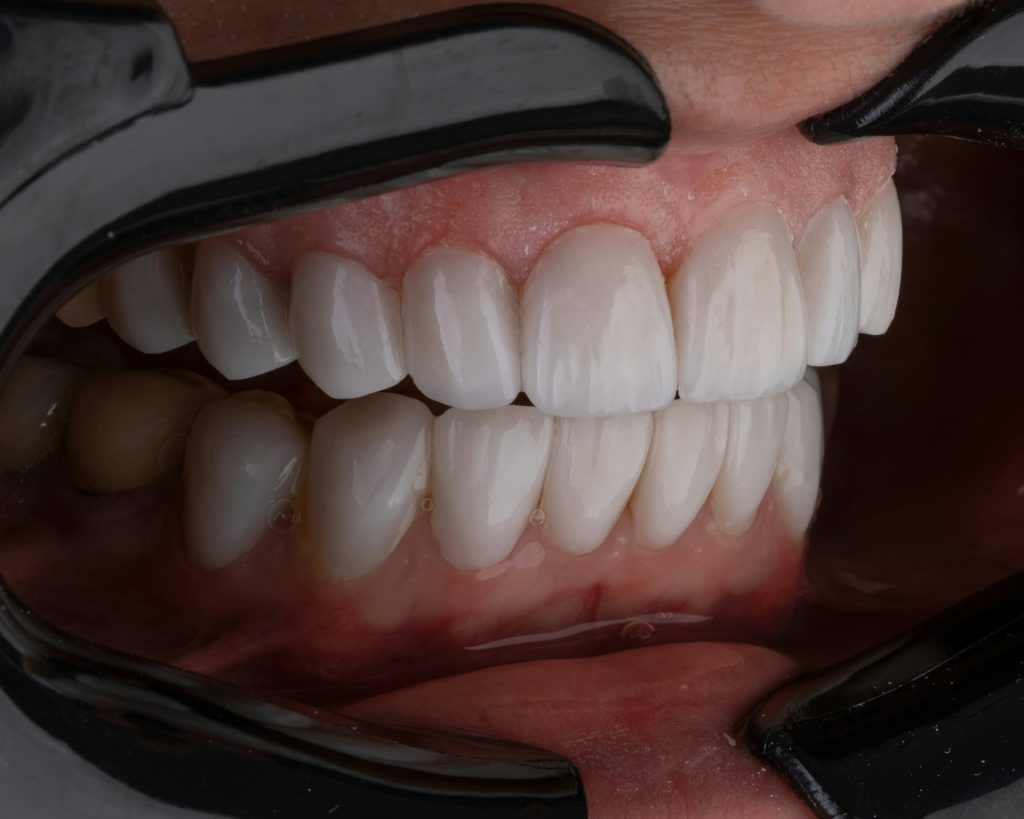Composite Veneers vs. Porcelain Veneers Which is Better?
When it comes to enhancing your smile, veneers offer a popular solution.
But with options like composite and porcelain veneers available, making a choice can be daunting.
This article aims to shed light on the differences between these two types of veneers. We’ll delve into their application process, durability, aesthetic outcomes, and cost.

We’ll also explore the maintenance required for each type, and factors to consider when making your decision.
Whether you’re a dental professional seeking more information, or a patient considering veneers, this comprehensive guide will provide valuable insights.
Stay tuned as we unravel the world of composite and porcelain veneers, helping you make an informed decision for your perfect smile.
Understanding Veneers: Composite and Porcelain
Veneers are thin shells designed to cover the front surface of teeth. They are used to improve the appearance of teeth by altering their color, shape, size, or length.
There are two main types of veneers: composite and porcelain. Both types serve the same purpose but differ in material, application process, and other factors.
Understanding these differences is crucial in making an informed decision. It helps ensure that the chosen veneers meet your specific dental needs and aesthetic desires.
Let’s delve deeper into what composite and porcelain veneers are, and how they differ.
What are Composite Veneers?
Composite veneers, also known as direct veneers, are made from a tooth-colored resin material. This material is applied directly to the teeth in layers.
The dentist then shapes and polishes these layers to achieve a natural look. Composite veneers are a popular choice due to their affordability and the speed of the application process.
What are Porcelain Veneers?
Porcelain veneers, on the other hand, are custom-made shells crafted in a dental laboratory. They are made to fit perfectly over your teeth, providing a natural and aesthetically pleasing appearance.
Porcelain veneers are known for their durability and resistance to staining, making them a long-lasting solution for a perfect smile.
Learn about veneers vs lumineers

The Application Process: Composite vs. Porcelain
The application process for composite and porcelain veneers differs significantly. These differences can impact the time commitment, cost, and overall patient experience.
Understanding the application process for each type of veneer can help you make an informed decision. It can also help set realistic expectations for the procedure.
How Composite Veneers are Applied
The application of composite veneers is typically completed in a single dental visit. The dentist first prepares the tooth surface by roughening it slightly.
Then, the composite resin material is applied in layers. Each layer is hardened with a special light before the next one is added. Once the desired thickness is achieved, the dentist shapes and polishes the veneer to match the rest of your teeth.
How Porcelain Veneers are Applied
The application of porcelain veneers, however, usually requires two dental visits. During the first visit, the dentist prepares the tooth by removing a small amount of enamel.
An impression of your teeth is then taken and sent to a dental laboratory. The lab creates the custom veneer, which is bonded to your tooth during the second visit. This process ensures a perfect fit and a natural look.
Durability and Longevity: A Comparison
When considering veneers, durability and longevity are key factors. Both composite and porcelain veneers offer different advantages in these areas.
Understanding the lifespan and durability of each option can help you make a decision that suits your lifestyle and budget.
Composite Veneers Durability
Composite veneers are known for their durability. They are made from a strong resin material that can withstand daily wear and tear.
However, they may be more prone to chipping or staining than porcelain veneers. Regular dental check-ups and good oral hygiene can help maintain their appearance and longevity.
Porcelain Veneers Longevity
Porcelain veneers, on the other hand, are renowned for their longevity. They are highly resistant to staining and can last up to 15 years with proper care.
While they may require a higher initial investment, their durability and long lifespan can make them a cost-effective choice in the long run.
Aesthetic Outcomes: Before and After
The aesthetic outcome is a crucial aspect when choosing between composite and porcelain veneers. Both types can significantly enhance your smile, but they offer different aesthetic results.
Before and after photos can provide a clear visual comparison. They can help you understand the potential transformation each type of veneer can offer.
Composite Veneers Before and After
Composite veneers can provide an immediate transformation. They can correct discoloration, minor misalignments, and gaps between teeth.
However, they may not offer the same level of shine and luster as porcelain veneers. The final result can depend on the skill of the dentist and the quality of the composite resin used.
Porcelain Veneers Before and After
Porcelain veneers, on the other hand, offer a high level of customization. They can be crafted to match the color, shape, and size of your natural teeth.
The result is often a more natural and radiant smile. Porcelain veneers can mimic the light-reflecting properties of natural teeth, providing a superior aesthetic outcome.
Cost Analysis: Investing in Your Smile
The cost of veneers can be a significant factor in your decision-making process. It’s important to consider this as an investment in your smile and overall confidence. Both composite and porcelain veneers come with different price tags, reflecting their materials, application process, and longevity.
The Cost of Composite Veneers
Composite veneers are generally less expensive than their porcelain counterparts. The cost reflects the simpler application process and the materials used.
However, considering their shorter lifespan and potential need for more frequent replacements or repairs, the long-term cost may be higher. It’s essential to factor in these potential future costs when considering composite veneers.
The Cost of Porcelain Veneers
Porcelain veneers, while more expensive upfront, offer a longer lifespan. This durability can make them a more cost-effective choice in the long run.
However, the initial cost can be a barrier for some patients. It’s important to discuss financing options with your dental professional to make this investment more manageable.
Maintenance and Care: Ensuring Veneer Longevity
Maintaining your veneers is crucial to ensure their longevity and keep your smile looking its best. Both composite and porcelain veneers require specific care routines. Regular dental check-ups are also essential to monitor the condition of your veneers and underlying natural teeth.
Caring for Composite Veneers
Composite veneers require diligent oral hygiene practices. Regular brushing and flossing are essential to prevent staining and plaque build-up.
Avoiding hard foods and habits like nail-biting can also help prevent chipping or damage. Regular professional cleanings can help maintain the shine and appearance of composite veneers.
Caring for Porcelain Veneers
Porcelain veneers are highly stain-resistant, but good oral hygiene is still vital. Regular brushing and flossing will help maintain the health of your natural teeth and gums.
While porcelain is durable, it’s still important to avoid habits that could cause damage, such as grinding your teeth or using them to open packages. Regular dental check-ups will ensure your veneers stay in top condition.
Making the Right Choice: Factors to Consider
Choosing between composite and porcelain veneers is a personal decision. It depends on various factors, including your dental health, aesthetic goals, budget, and lifestyle. It’s important to discuss these factors with your dentist to make an informed decision.
Your dentist’s expertise and experience also play a crucial role. They can guide you on the best choice based on your specific needs and expectations. Remember, the goal is to enhance your smile while preserving your dental health.
Suitability for Different Dental Issues
Composite veneers are often suitable for minor cosmetic changes. They can fix small chips, cracks, or discoloration. They’re also a good choice if you want a less invasive procedure.
Porcelain veneers, on the other hand, are ideal for more significant transformations. They can correct more extensive damage or discoloration. They’re also a good choice if you’re looking for a more durable and long-lasting solution.
Personal Preferences and Lifestyle
Your lifestyle and personal preferences also matter. If you’re looking for a quick fix, composite veneers might be the right choice. They can be applied in a single visit and are less expensive.
However, if you’re looking for a more permanent solution and are willing to invest more time and money, porcelain veneers might be a better fit. They offer a more natural look and are more resistant to staining and chipping.
Conclusion: Your Smile, Your Decision
In the end, the choice between composite and porcelain veneers is a personal one. It’s about finding the right balance between your aesthetic goals, budget, and lifestyle. Both options can significantly enhance your smile and boost your confidence.
Remember, it’s essential to have a thorough consultation with a skilled cosmetic dentist. They can provide valuable insights and guide you towards the best decision for your unique needs. After all, your smile is a reflection of you, and it deserves the best care possible.





Leave a Reply
You must be logged in to post a comment.